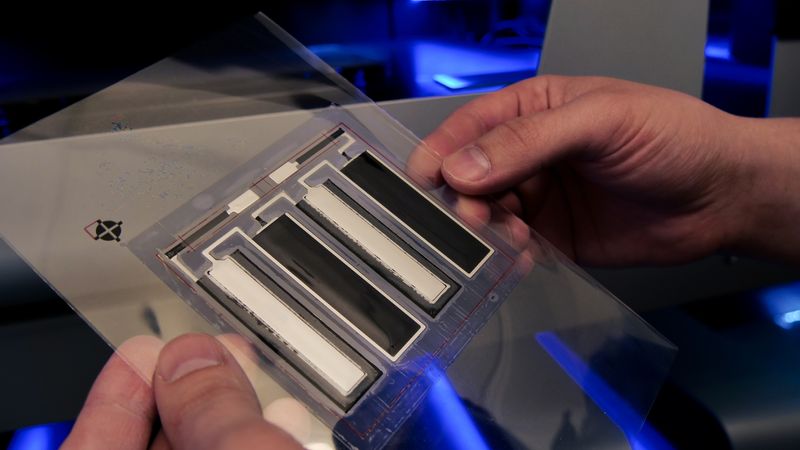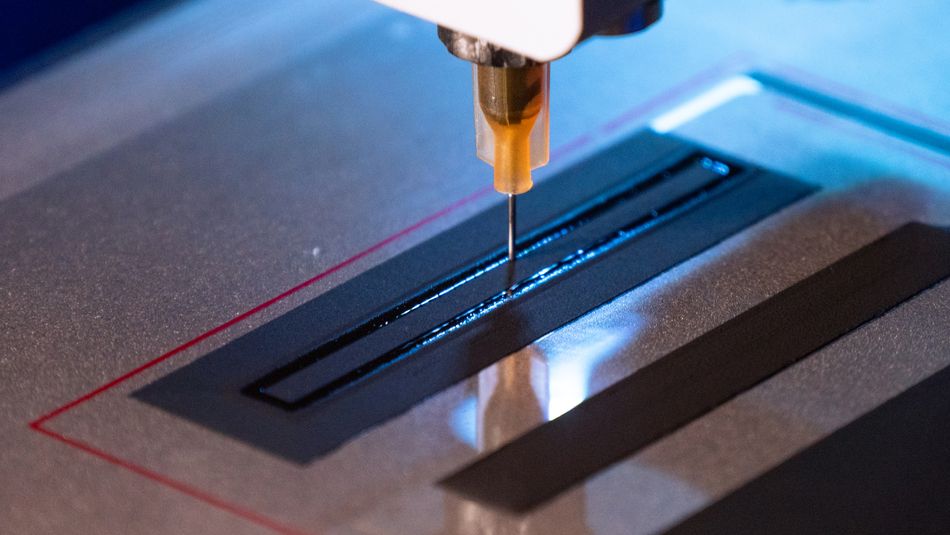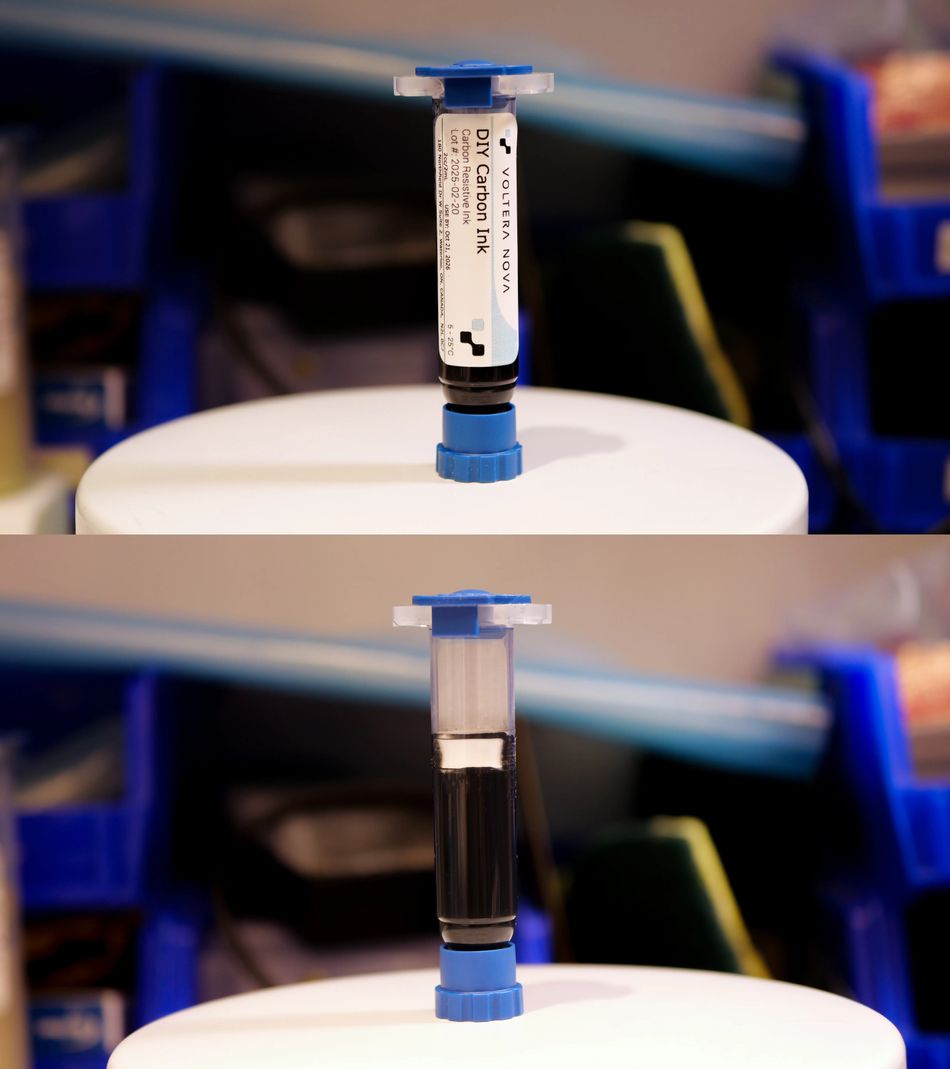What are Flexible Printed Batteries?
Flexible printed batteries, highly customizable in size and shape, are the future. Learn more about the technologies enabling these innovative energy storage devices and their latest use cases.

A flexible printed battery developed by Voltera
While battery technology has evolved tremendously since the invention of the first Volta battery in the early 1800s, even two centuries later batteries have still tended to be bulky and rigid.[1] Even some of the smallest batteries used today—button cells used to power watches and portable electronics—are limited in their application, both by their capacity and their rigidity. Today especially, with the proliferation and advancement of miniaturized electronics and Internet of Things (IoT) devices, there is a growing demand for compact, conformable and efficient batteries.
Fortunately, the rise of sophisticated printing systems, such as Voltera’s Direct Ink Writing (DIW) solutions, are enabling the production of flexible printed batteries, which are literally powering next-gen electronics, from wearable devices, to conformable sensors, to rechargeable IoT products. In this article, we are delving into how flexible printed batteries work, the material innovations and production technologies that are enabling them, and the challenges associated with further commercializing the technology.
What is a flexible printed battery?
In the simplest terms, a flexible printed battery is an energy storage device that can flex and conform to the electronics it is integrated in. This type of battery is made using a printing process that selectively deposits conductive inks, electrolyte paste, and separator material onto a thin flexible substrate, such as PET.
The key value of the flexible printed battery comes from the fact that it can be designed in any shape and in highly compact sizes, meaning that it can be customized for specific applications and integrated seamlessly into a range of electronic products. For example, in the consumer electronics sector, flexible printed batteries can enable functional electronics like key fobs to be integrated into subtle wearables, like rings, or a battery could be embedded directly into a wireless earphone case.[2]
The applications for flexible printed electronics go beyond consumer goods. In the medical industry, conformable batteries could power biosensors that monitor vital health metrics in real time. In retail, they could be integrated into shelf price tags making it easier to update prices and rebates, as well as in smart packaging that can track the temperature and stability of a product. In the context of engineering and infrastructure, sensors that monitor buildings, bridges, and environmental factors can benefit from compact and flexible battery power. Other applications for flexible printed batteries include bendable screens, RFID tags and more. Ultimately, flexible printed batteries can keep innovative electronic devices up and running without adding any bulk.
Flexible battery case studies
Flexible printed batteries are at the forefront of battery innovations today and are still very much an emerging technology. Still, there are a number of use cases, largely from the research sector, that demonstrate how printing technologies like DIW can produce flexible batteries for a range of different applications.
Seven-layer flexible battery
In a case study led by Voltera, the company printed a seven-layer battery using its NOVA materials dispensing system.[3] Made on a flexible PET substrate, the battery consisted of the following layers, each deposited using a precision nozzle and a variety of Saral inks:
Silver conductive layer
Carbon current collector layer
Zinc anode layer
Manganese dioxide cathode layer
Separator layer
Hot melt glue layer
Zinc chloride electrolyte layer
Once the printed layers were complete, the PET substrate was trimmed and folded on itself. From there, the battery was laminated, resulting in a highly flexible, 500 µm-thick (excluding the substrate) battery with a voltage of 2.4 V. This level of voltage makes the energy storage device suitable for low-power electronics like LEDs, handheld GPS devices, toys, electric toothbrushes, security cameras and more. Watch video here:
3R silver oxide-gallium battery
In another use case, a team of researchers based out of Portugal’s University of Coimbra used a Voltera printer to make recyclable soft-matter thin-film batteries.[4] You can read more about the research paper, 3R Batteries: Resilient, Repairable, and Recyclable Based on Liquid Gallium Electrode, here.
In addition to the two aforementioned case studies, there are several other projects in which Voltera’s technology is playing a central role, including in the development of stretchable silver-gallium batteries [5], sodium-ion batteries [6] and integrated battery-on-board systems [7].
The technologies enabling flexible printed batteries
Use cases such as the ones covered are made possible by new and innovative technologies like Voltera’s DIW printing systems. Today, Voltera’s printers, NOVA in particular, are being used by developers and research labs all over the world to develop flexible printed batteries.
Specifically, the company’s DIW printers enable the precise deposition of various types of conductive and dielectric inks onto thin and flexible substrates. For example, NOVA can print a line width as fine as 100 µm and up to four stack-up layers—all without the need for any tooling or waste.
Of course, materials are also central to the creation of next-generation batteries and recent strides in material development have been essential to printing these components. Materials like liquid gallium, graphene gels, and polymer composites are offering developers the required properties (i.e. flexibility, stretchability, and energy density) to create resilient and conformable energy storage devices.
Overall, the most significant advantage of Voltera’s DIW solutions is that they allow researchers and product developers to test a wide range of materials and substrates, to rapidly iterate flexible printed batteries, and create flexible printed batteries using a single platform.
Challenges for commercialization
As the technologies enabling flexible printed batteries gain ground in terms of capacity and adoption, there are still challenges to be faced, particularly when it comes to the commercialization of flexible printed batteries.
These challenges are primarily related to performance and capacity. Printed flexible batteries are still limited in their voltage and energy density, making more conventional battery solutions more viable for applications that require more energy and long cycle lives. This challenge is being tackled on the materials front as well as through process optimization and structural battery design innovations.
Other performance issues related to printed flexible batteries are related to the batteries’ environmental resistance and operating temperature range. To address this, techniques like encapsulation are being explored, which can protect the batteries from temperature fluctuations and moisture. To make the thin-film batteries more durable and resistant to mechanical fatigue, solutions like self-healing materials offer a promising solution.
All that to say, the challenges currently associated with flexible printed batteries can be understood more as growing pains that will be overcome and solved as the technology matures thanks in part to agile platforms like Voltera’s printers.
Conclusion
Flexible printed batteries have emerged to meet the increasing demand for miniaturized electronics, smart devices, and wearable sensors. Unlike more conventional batteries, which are encapsulated in standardized, rigid housings, flexible printed batteries have the unprecedented benefit of being customizable to practically any size and shape, meaning that they can be seamlessly integrated into a range of products, whether it’s a key-fob ring or a smart label in a shop.
Voltera’s printing technologies have been a key enabler of this new era of energy storage solutions, as have recent material advances. Ultimately, hardware, materials, and the skills of talented research teams are driving innovation in flexible printed batteries and will unlock greater battery efficiency and game-changing electronic applications.
References
[1] Alarco, Jose; Talbot, Peter. The history and development of batteries [Internet]. Phys.org, April 30, 2015. https://phys.org/news/2015-04-history-batteries.html
[2] Printed Batteries [Internet]. Voltera, 2025. https://www.voltera.io/use-cases/applications/printed-batteries
[3] Printing a Magnesium Zinc Battery with Saral Inks on PET [Internet]. Voltera, 2025. https://www.voltera.io/use-cases/white-papers/printing-magnesium-zinc-battery-saral-inks-pet
[4] Parvini E, Hajalilou A, Lopes PA, Silva AF, Tiago MS, Fernandes PM, de Almeida AT, Tavakoli M. 3R Batteries: Resilient, Repairable, and Recyclable Based on Liquid Gallium Electrode. Advanced Materials Technologies. 2024 Jul;9(14):2301189. https://doi.org/10.1002/admt.202301189
[5] Costa GC. Digitally Printed Stretchable Silver-Gallium Battery (Master's thesis). https://hdl.handle.net/10316/98119
[6] Martinez AC, Schiaffino EM, Aranzola AP, Fernandez CA, Seol ML, Sherrard CG, Jones J, Huddleston WH, Dornbusch DA, Sreenivasan ST, Cortes P. Multiprocess 3D printing of sodium-ion batteries via vat photopolymerization and direct ink writing. Journal of Physics: Energy. 2023 Sep 27;5(4):045010. https://iopscience.iop.org/article/10.1088/2515-7655/acf958/meta
[7] Freitas MC, Sanati AL, Lopes PA, Silva AF, Tavakoli M. 3D Printed Gallium Battery with Outstanding Energy Storage: Toward Fully Printed Battery‐on‐the‐Board Soft Electronics. Small. 2024 May;20(20):2304716. https://doi.org/10.1002/smll.202304716



